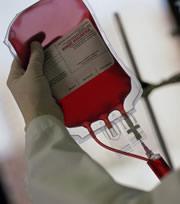 Anyone can receive O type blood, but stocks constantly run low.Getty
Anyone can receive O type blood, but stocks constantly run low.GettyScientists have discovered enzymes that can efficiently convert blood groups A, B and AB into the 'universal' O group — which can be given to anyone but is always in short supply.
The two novel glycosidase enzymes were identified in bacteria by an international team led by Henrik Clausen of the University of Copenhagen in Denmark. The researchers hope that the enzymes will both improve the erratic supplies of blood around the world, and also the safety of transfusions. Clinical trials to test the safety and effectiveness of their converted blood are being planned.
The ABO blood-type system is based on the presence or absence of the sugar-based antigens 'A' and 'B' on red blood cells. Type O blood cells have neither A nor B antigens, so may be safely transfused into anyone. But types A, B and AB blood do, and cause life-threatening immune reactions if they are given to patients with a different blood group. The bacterial glycosidase enzymes strip these antigens away from A, B and AB blood.
The idea of such antigen-stripping goes back to the early 1980s, with the discovery of an enzyme in coffee beans that removes B antigens from red blood cells1. Early-stage clinical trials showed that the converted blood could be safely transfused into individuals of different blood groups; no traces of enzyme or antigen remained to cause reactions2. But the enzyme reaction was far too inefficient to make large-scale conversion practical.
“The biggest advantage [is] eliminating incidents of giving the wrong blood”
Martin Olsson, Lund University Hospital Blood Centre
Clausen's team screened 2,500 extracts from different bacteria and fungi for their ability to cleave off A and B antigens. The newly discovered bacterial 'B' enzyme is nearly 1,000 times more efficient then the coffee-bean B enzyme — the additional discovery of an enzyme to remove A antigens means that all blood types can now be converted. The work is reported in Nature Biotechnology3.
Common stock
Type O is the most common blood group, but stocks constantly run low because it is used in all emergency situations where there is no time to determine the patient's own group.
An additional pressure on type-O blood, particularly in the United States, comes from the mismatch between blood donors and recipients. Most US donors are Caucasian, amongst whom 45% of people are blood group O. But more than half of African Americans, and nearly all native Americans are O, and so require type-O blood.
Also the donor population is shrinking as fears of transfusion-transmitted infections of new diseases such as SARS, mad-cow disease and West Nile disease remove from the pool donors who may have been exposed.
"Restrictions are getting almost comical," says Martin Olsson, head of the Lund University Hospital Blood Centre in Sweden, and a member of the international team. "At different times, the US excluded from donation those who had recently visited Europe in case they had contact with BSE, and Europe has excluded those who recently visited the US where they perceive a higher risk of HIV."
ADVERTISEMENT
Yet in practice the greatest risk in blood transfusion is not the transmission of disease but the accidental transfusion of the wrong blood group, he says. "As a clinician, I see the biggest advantage of the new enzyme technology as eliminating incidents of giving the wrong blood."
The Boston-based company ZymeQuest is developing the enzyme technology for commercial use in blood centres. Early-stage clinical trials are underway. If all goes well, blood centres could be using the technologies in just a few years.
Visit our madesuitableforall.html">newsblog to read and post comments about this story.
